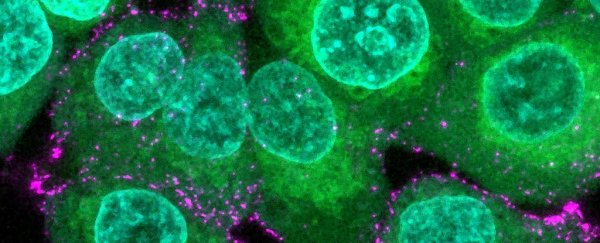If you want to truly understand what makes a machine tick, you need to tinker. Swap gears, lock a lever, loosen a spring, and watch how it goes.
When the machine is a deadly virus, you can't afford to be so cavalier with its molecular clockwork. But researchers are getting around this problem by making minimalist versions of dangerous microbes that barely teeter on the edge of functionality.
Using this method for SARS-CoV-2 – the pathogen behind the ongoing coronavirus pandemic – has revealed a surprising way the virus's spikes act as a kind of switchblade, allowing it to hide more easily from our immune system.
Researchers from across Germany and the UK came up with 'lite' versions of SARS-CoV-2 to safely analyze its infectious behavior under lab conditions.
Described as "synthetic minimal virions", the particles consist of modules created from scratch to provide insights into key features of the virus, without an ability to operate together as an infectious unit.
"Even more important for us, as we build these synthetic virions from scratch, is that we can precisely design their composition and structure", says biologist Oskar Staufer, formerly from the Max Planck Institute for Medical Research and currently working at the University of Oxford.
"This allows us to perform a very systematic, step-by-step study on distinct mechanisms."
The first mechanism the team turned their attention to was the eponymous corona (crown) of spikes jutting from the virus's coat.
Ever since the outbreak exploded onto the world stage in early 2020, virologists have sought to understand just how these projections helps the pathogen in its quest to survive and reproduce.
It's become increasingly clear the proteins are both a help and a hindrance for the tiny invader.
Going in its favor, the spikes act like a key for a type of cellular lock called an ACE2 receptor, tricking tissues into permitting the virus entry.
Yet the proteins are also an easily identifiable feature for antibodies to latch onto and trigger a clean-out. We even base vaccines on its prominence, providing naïve, uninfected immune systems with an impression of its structure to better prepare them for an actual infection.
It turns out, the crafty coronavirus has learned a thing or two in its time that helps it get around this inconvenience.
The researchers focused on the way specific fatty acid-type immune molecules interact with the spikes in order to generate inflammation.
Prior research had already highlighted a section of the spike the immune molecules stuck to. Given this region was stubbornly resistant to change, it's fair to assume it must be a pretty important structure for the virus's survival.
Now we know why. The researchers noticed the spike underwent a structural change when the immune molecule grabbed on, effectively folding itself away.
This makes it much harder to break into any nearby cells. But while in this configuration, it's also harder for the virus to attract antibodies.
"By 'ducking down' … the spike protein upon binding of inflammatory fatty acids, the virus becomes less visible to the immune system," says Staufer.
"This could be a mechanism to avoid detection by the host and a strong immune response for a longer period of time and increase total infection efficiency."
It's an insight into a devastating virus that continues to surprise us, and a preview of how synthetic models like this might give us the edge in limiting the pathogen's long-term impact on populations around the globe.
This research was published in Nature Communications.
